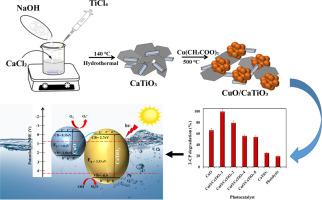Constructing strong built-in high optical absorption in CaTiO3 perovskite with CuO heterojunction for enhanced solar-driven photocatalytic degradation of 2-chlorophenol in water
IF 6.3
3区 工程技术
Q1 ENGINEERING, CHEMICAL
Journal of the Taiwan Institute of Chemical Engineers
Pub Date : 2025-09-15
DOI:10.1016/j.jtice.2025.106387
引用次数: 0
Abstract
Enhancing the optical absorption ability and interfacial charge separation efficiency of perovskites signifies a potential strategy for boosting their photocatalytic activity. Calcium titanate-based perovskite is one of the most widely used nanomaterial photocatalysts. However, it is usually affected by a major limitation of large band gap energy, making it only photochemically active within ultraviolet light regions.
Methods: Herein, the successful construction of CuO/CaTiO3 heterojunction by combining two semiconductors with distinct semiconducting properties from tetragon and hexagonal sheets of CaTiO3 obtained by hydrothermal, followed by fabrication of CuO/CaTiO3 photocatalyst composite for the degradation of 2-chlorophenol under sunlight irradiation, was reported. Various stoichiometric ratio of the composite was synthesized by changing the amount of CuO to optimize the best-performing photocatalyst.
Significant Findings: The characterization data of the as-prepared CuO/CaTiO3 confirms the successful integration of CuO into the CaTiO3 crystal lattice, which enhanced its visible light absorption ability and reduction in band gap energy from 3.53 eV to 2.71 eV. About four times higher photodegradation efficiency (99.28 %) was achieved after 4 h irradiation time, and the photocatalyst showed good chemical stability even after 5 application cycles. Hence, this research study highlights the potential for constructing a photocatalyst heterostructure as a viable strategy for modifying the photocatalytic properties of CaTiO3 perovskite.

在CuO异质结CaTiO3钙钛矿中构建强内建高光吸收增强光催化降解水中2-氯苯酚
提高钙钛矿的光吸收能力和界面电荷分离效率是提高其光催化活性的潜在策略。钛酸钙基钙钛矿是目前应用最广泛的纳米光催化剂之一。然而,它通常受到大带隙能量的主要限制,使其仅在紫外光区域具有光化学活性。方法:利用水热法制得的CaTiO3的四边形和六边形薄片,成功地将两种具有不同半导体性质的半导体结合在一起,构建CuO/CaTiO3异质结,然后制备CuO/CaTiO3光催化剂复合材料,用于在阳光照射下降解2-氯酚。通过改变CuO的用量,合成了不同化学计量比的复合材料,以优化性能最佳的光催化剂。重要发现:制备的CuO/CaTiO3的表征数据证实了CuO成功整合到CaTiO3晶格中,增强了CaTiO3的可见光吸收能力,并将带隙能量从3.53 eV降低到2.71 eV。经过4 h的辐照后,光催化剂的降解效率提高了约4倍(99.28%),并且在5次辐照循环后仍表现出良好的化学稳定性。因此,本研究强调了构建光催化剂异质结构作为修饰CaTiO3钙钛矿光催化性能的可行策略的潜力。
本文章由计算机程序翻译,如有差异,请以英文原文为准。
求助全文
约1分钟内获得全文
求助全文
来源期刊
CiteScore
9.10
自引率
14.00%
发文量
362
审稿时长
35 days
期刊介绍:
Journal of the Taiwan Institute of Chemical Engineers (formerly known as Journal of the Chinese Institute of Chemical Engineers) publishes original works, from fundamental principles to practical applications, in the broad field of chemical engineering with special focus on three aspects: Chemical and Biomolecular Science and Technology, Energy and Environmental Science and Technology, and Materials Science and Technology. Authors should choose for their manuscript an appropriate aspect section and a few related classifications when submitting to the journal online.

 求助内容:
求助内容: 应助结果提醒方式:
应助结果提醒方式:


